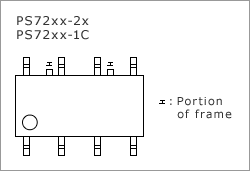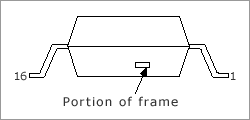Safety Information on Opto Electronics Devices (PDF | English, 日本語)
1. Precautions During Mounting
Resin that is highly effective in conducting light from the outside to the inside is required for opto-electronics devices to obtain the requisite optical characteristics. In particular, the nearly pure, transparent epoxy resin used in light-emitting diodes and photodetectors differs from that used in common ICs. As a result, opto-electronics devices are somewhat weaker in terms of thermal, chemical, mechanical and abrasive stress strength compared to other semiconductors, and particular care should be used during mounting.
The mounting method and general precautions are provided below. Please refer to them during work to prevent problems.
1.1 Soldering
Soldering is to be done following the conditions specified for each device. Be sure to also observe the following general precautions when soldering: Do not perform soldering while residual mechanical stress is applied between leads; Do not apply stress such as by pulling, twisting, compressing etc. between leads during high-temperature soldering, as this may cause a break or short in the leads.
Rosin flux containing small amount of chlorine is recommended.
1.2 Cleaning
After soldering parts on a printed board, use the recommended cleaning conditions listed in Table 1-2 to remove the flux.
- Be careful during brushing not to delete markings or the scratch mold resin surface.
- Especially, fleon-based and chlorine-based solvents easily damage and contaminate the environments, and regulations to limit the production and consumption of these solvents have been reinforced in recent years.
- Prior to adopting a cleaning method of a solvent, check through actual experiment that it is safe to use.
- During cleaning of photodetectors, dirt and stains tend to adhere and these may cause malfunctions. Therefore, take precautions to avoid this during cleaning.
- Recommended solvent for flux cleaning:
- Ethyl alcohol, methyl alcohol, isopropyl alcohol, P3 cold cleaner, pine alpha ST-100S,
- bioact EC-7/EC-7R, clean through-700 series
- Cleaning method
- Solvent Bath
- Solvent temperature: 45°C or under, Duration: 3 minutes or less Ultrasonic Cleaning
- Ultrasound Cleaning
- Ultrasound output: 15 W/liter or under, Duration: 30 seconds or less
- Solvent temperature: Maintain low temperature of approx. 40°C
- Frequency: 28 kHz
- Steam Cleaning
- Steam temperature: 45°C or under, Duration: 3 minutes or less
- Solvent Bath
2. General Precautions
2.1 Precautions Regarding Static Electricity
Great care must be taken to protect optoelectronic devices from destruction by static electricity.
Therefore, keep static electricity as low as possible, and select the environment for handling optoelectronic devices accordingly.
Do not place materials that tend to produce static electricity in the working environment; where static electricity is generated, take measures to keep it under 100 V. Moreover, avoid low-humidity conditions by using a humidifier during dry periods as needed.
During work, avoid as much as possible materials that become easily charged electrically (especially chemical fibers and plastics), and use instead conductive materials (anti-static shield pack, conductive mat.)
Operators must wear an earth band (with a 1 MΩ resistance) during work.
Place conductive mats beneath measuring and test devices as well as work benches as a measure against static electricity.
2.2 Additional Precautions
The storage location for optoelectronic devices should be as stable as possible in terms of temperature (5 to 30°C) and humidity (20 to 70%). Be careful not to place weight on optoelectronic devices in storage.
When transporting optoelectronic devices, be careful to protect them from vibrations and shocks.
- Cautions regarding noise
Be aware that when voltage is applied suddenly between the photocoupler's input and output or between corrector-emitters at startup, the output side may enter the on state, even if the voltage is within the absolute maximum ratings.
- Products in dry pack
After opening the dry pack, solder the products within the valid storage period specified on the label on the dry pack.
- Avoid shorting between portion of frame and leads.

- Portion of frame

This device should be used without wiring the underside.
2.3 Disposal Method
Cautions on Handling Devices Containing Gallium Arsenide Optoelectronic devices contain gallium arsenide (GaAs).
- Do not destroy or burn the product.
- Do not cut or cleave off any part of the product.
- Do not crush or chemically dissolve the product.
- Do not put the product in the mouth.